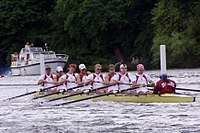
Photo from wikipedia
Approximate models of interacting surfaces competed against a supercomputer solution Describing the way two surfaces touch and make contact may seem simple, but it is not. Fully describing the elastic… Click to show full abstract
Approximate models of interacting surfaces competed against a supercomputer solution Describing the way two surfaces touch and make contact may seem simple, but it is not. Fully describing the elastic deformation of ideally smooth contacting bodies, under even low applied pressure, involves second-order partial differential equations and fourth-rank elastic constant tensors. For more realistic rough surfaces, the problem becomes a multiscale exercise in surface-height statistics, even before including complex phenomena such as adhesion, plasticity, and fracture. A recent research competition, the “Contact Mechanics Challenge” (1), was designed to test various approximate methods for solving this problem. A hypothetical rough surface was generated, and the community was invited to model contact with this surface with competing theories for the calculation of properties, including contact area and pressure. A supercomputer-generated numerical solution was kept secret until competition entries were received. The comparison of results (2) provides insights into the relative merits of competing models and even experimental approaches to the problem.
Journal Title: Science
Year Published: 2018
Link to full text (if available)
Share on Social Media: Sign Up to like & get
recommendations!